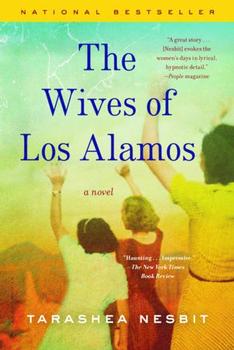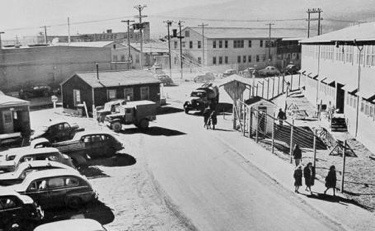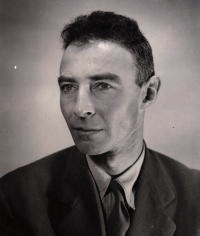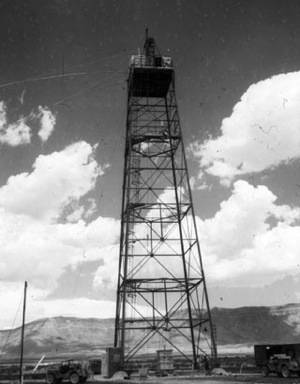Summary | Excerpt | Reading Guide | Reviews | Beyond the Book | Read-Alikes | Genres & Themes | Author Bio

Critics' Opinion:
Readers' Opinion:
First Published:
Feb 2014, 240 pages
Paperback:
Jan 2015, 240 pages
 Book Reviewed by:
Book Reviewed by:
Suzanne Reeder
Buy This Book
This article relates to The Wives of Los Alamos
During World War II an isolated area in the American Southwest became the primary research and development site for the creation of the most destructive force in human history. As part of the Allied mission to vanquish the threat of the German nuclear development program, scientists and engineers built the atomic bomb in Los Alamos, New Mexico. This top-secret endeavor had a code name: the Manhattan Project, which TaraShea Nesbit explores from a collective women's point of view in her debut novel, The Wives of Los Alamos. The project received its code name in late 1941. The term came about because the program started under the Manhattan Engineering District of the War Department.
 Before the Los Alamos site was chosen, research was conducted at Columbia University, the University of Chicago, and the University of California at Berkeley. By mid-1942 the Army Corps of Engineers was put in charge of the project. General Leslie Groves was selected in September as its military head.
Before the Los Alamos site was chosen, research was conducted at Columbia University, the University of Chicago, and the University of California at Berkeley. By mid-1942 the Army Corps of Engineers was put in charge of the project. General Leslie Groves was selected in September as its military head.
In December 1942 the scientist Enrico Fermi (who had escaped Fascist Italy and moved to the U.S.) achieved a breakthrough when he led a group of physicists to produce the first controlled nuclear chain reaction at the University of Chicago's Stagg Field. As a result, funding for the project significantly increased, and nuclear facilities were built at Oak Ridge, Tennessee and Hanford, Washington.
 The difficulties in maintaining secrecy at so many different sites motivated a need for a centralized laboratory. Due to the gravity of the project, the location required careful consideration. Groves — along with American theoretical physicist J. Robert Oppenheimer, director of the Los Alamos lab — narrowed their choices to the area occupied by the Los Alamos Ranch School, which they found ideal for many reasons. The school was on sale and, though isolated, Los Alamos was still accessible, offered an available labor force and an adequate water supply. Oppenheimer was also familiar with the area. He had a ranch nearby in the Pecos Valley of the Sangre de Cristo Mountains.
The difficulties in maintaining secrecy at so many different sites motivated a need for a centralized laboratory. Due to the gravity of the project, the location required careful consideration. Groves — along with American theoretical physicist J. Robert Oppenheimer, director of the Los Alamos lab — narrowed their choices to the area occupied by the Los Alamos Ranch School, which they found ideal for many reasons. The school was on sale and, though isolated, Los Alamos was still accessible, offered an available labor force and an adequate water supply. Oppenheimer was also familiar with the area. He had a ranch nearby in the Pecos Valley of the Sangre de Cristo Mountains.
Initially, officials assumed the school buildings would afford enough housing for the estimated 30 scientists who would work there. During the war, however, the number of residents surpassed 6,000, leaving the scientists—and their families who had relocated there from all over the country—to experience ongoing shortages of water and housing.
At the new base of operations, Oppenheimer drew together some of the most brilliant scientists in history, including Fermi, Hans Bethe, and Richard Feynman. Work on the bomb continued without the Axis powers knowing, yet American leaders later learned that a Soviet spy had remained undetected. Klaus Fuchs, a German-born British citizen and scientist, worked in the theoretical division under Bethe at the Los Alamos lab. It wasn't until 1950 that Fuchs—who had returned to Britain—was sentenced to 14 years in prison. He was released after nine years and moved to East Germany, where he continued his scientific career. He died at age 76 in 1988.
 Adolf Hitler committed suicide April 30, 1945. Germany surrendered in May, and the focus of the conflict transferred to the Pacific. By summer, Oppenheimer was ready to test the first bomb.
Adolf Hitler committed suicide April 30, 1945. Germany surrendered in May, and the focus of the conflict transferred to the Pacific. By summer, Oppenheimer was ready to test the first bomb.
At Trinity Site near Alamogordo, New Mexico, the bomb was tested July 16. President Harry Truman was informed of the successful results. Soon he made the decision to unleash the atomic bomb on Japan. The first bomb detonated over Hiroshima August 6 and a second, differently designed and more powerful atomic bomb dropped over Nagasaki August 9. Japan subsequently agreed to an unconditional surrender. World War II formally ended in September 1945.
As part of the Manhattan Project, the goal of the Los Alamos lab — to end the war through the use of atomic weapons — was undeniably accomplished. But the creation and devastation of these unleashed weapons remains fiercely controversial to this day.
Picture of downtown Los Alamos from National Nuclear Security Administration
Picture of Robert Oppenheimer from Los Alamos Historical Society
Picture of Trinity site from Atomicarchive.com
Filed under People, Eras & Events
![]() This "beyond the book article" relates to The Wives of Los Alamos. It originally ran in March 2014 and has been updated for the
January 2015 paperback edition.
Go to magazine.
This "beyond the book article" relates to The Wives of Los Alamos. It originally ran in March 2014 and has been updated for the
January 2015 paperback edition.
Go to magazine.





The Funeral Cryer by Wenyan Lu
Debut novelist Wenyan Lu brings us this witty yet profound story about one woman's midlife reawakening in contemporary rural China.
Your guide toexceptional books
BookBrowse seeks out and recommends the best in contemporary fiction and nonfiction—books that not only engage and entertain but also deepen our understanding of ourselves and the world around us.